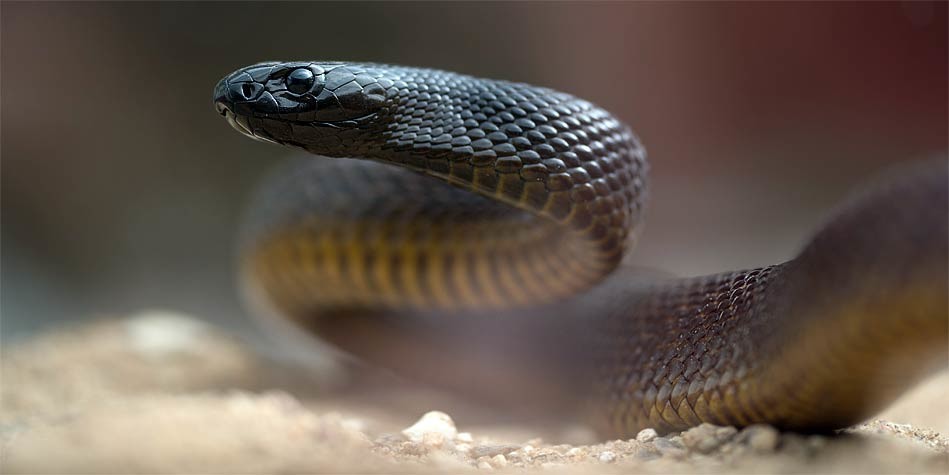Inland taipan – the most venomous snake
Inland taipan (Oxyuranus microlepidotus)
The most venomous snake in the world
The inland taipan is the number one snake on the list of the most venomous snakes living today on Earth. During a single bite this snake injects a portion of venom able to kill 100 people! Similarly to the whole 10 most venomous snakes, the inland taipan lives in Australia. It has the most toxic venom known to science today.
Classification
- Class: Reptilia
- Order: Squamata
- Suborder: Serpentes
- Family: Elapidae
- Genus: Oxyuranus
- Species: Inland taipan (Oxyuranus microlepidotus)
- Names: inland taipan, western taipan, small-scaled snake, fierce snake

Areas of occurrence
Inland taipan lives only in the Australian deserts.
Characteristics
Inland taipan changes its coloration depending on the season of the year. During summer it becomes straw-colored, dark brown in winter. It is a result of adapting to a harsh climate it lives in and allows an appropriate body heat regulation through changing the level of sunlight absorption. Taipan`s average length is 1.8 meters (5.9 ft), but it can grow as long as 2.5 m (8.2 ft).
Although taipan has the most toxic venom known known to science, its common name ‘Fierce Snake’ fits only the description of its venom rather than character. It actually is a very venomous snake, yet in reality it is also very shy and always prefers to flee when in danger.
This snake is typically solitary.

Diet
The inland taipan`s diet consists of almost only small mammals. Rats are its favorite food.
Breeding
This snake`s breeding depends on the rat population. In an abundant year, when rat population grows in numbers, the corresponding number of those dangerous snakes grows proportionally. A female normally lays from 12 to 20 eggs.

The most toxic venom known to mankind
Lethal Dose (LD) is an indication of toxicity of a given substance, or its harmfulness. LD50 (the mortality of half of the specimen) has varies in value depending on the application technique (orally, intravenously, intramuscularly, through inhalation).
In case of an inland taipan LD50 may appear with the following values:
- LD50SC (subcutaneously) – 0.106 mg/kg – kills the half of 416 thousand mice / the median of LD50SC is 0.025 mg/kg)
- LD50SCII (subcutaneously in the bovine serum albumin ) – 0.01 mg/kg – kills half of 2 million mice
- LD50IV (intravenously) – 0.013 mg/kg – kills half of 3.3 million mice
- LD50IP (intraperitoneal) – 0.009 mg/kg – kills half of 4.9 million mice
- LD50IM (intramuscularly) – we lack sufficient data
In case of a subcutaneous injection the median lethal dose LD50 of inland taipan`s venom is only 0.025 mg/kg (mice tests).
The maximum portion of venom injected during a single bite is 100 mg. This means that a single bite could kill 100 adult people. Time required for venom to take effect is 45 minutes. However humans are extremely rarely bitten by the taipan and people hospitalized after such a bite – survived.

Characteristic / size
Inland taipan (Oxyuranus microlepidotus)
- Length: 180 – 250 cm
- Ffangs: 3.5 – 6.2 mm
- Lifespan: 10 – 15 years in the wild, over 20 years in captivity
- Venom dose: up to 110 mg (average 44 mg)
- Venom toxicity: LD50SC: 0.025 mg/kg

Recommended
- Snakes
- Most venomous snakes
- Black mamba
- Anaconda
- Titanoboa
- Longest snakes
- Fastest animals
- Fastest birds
- Largest eagles


















